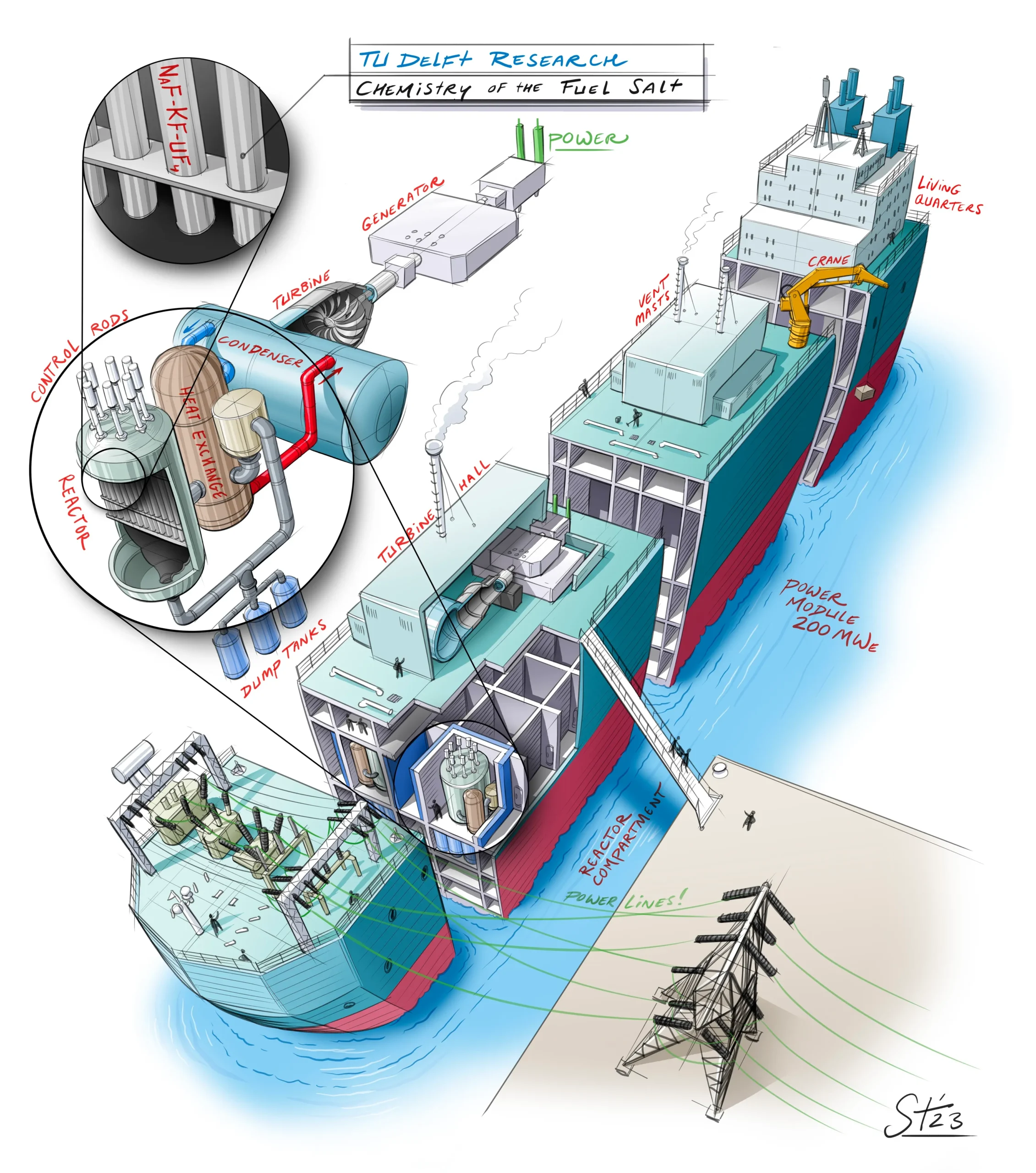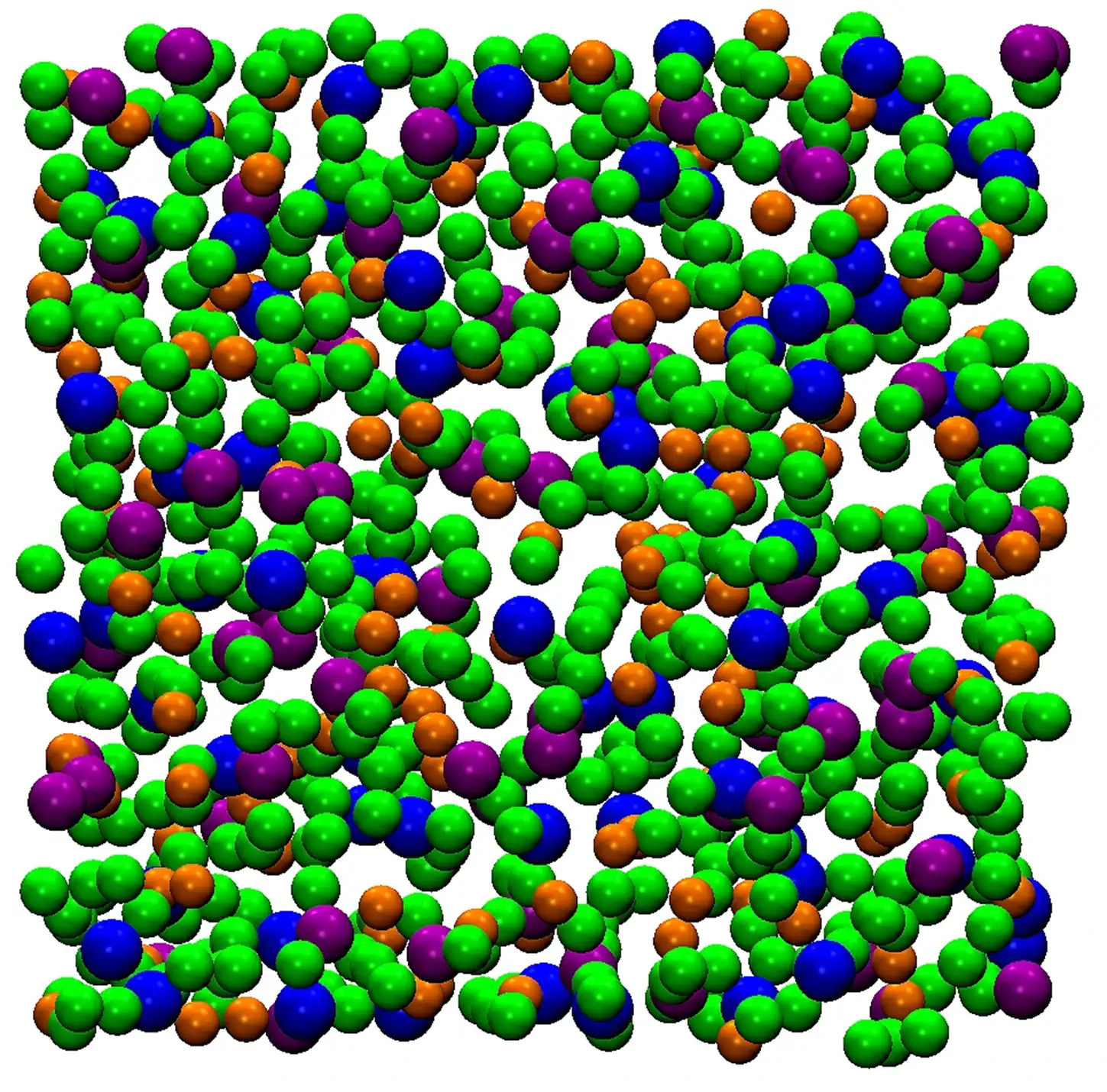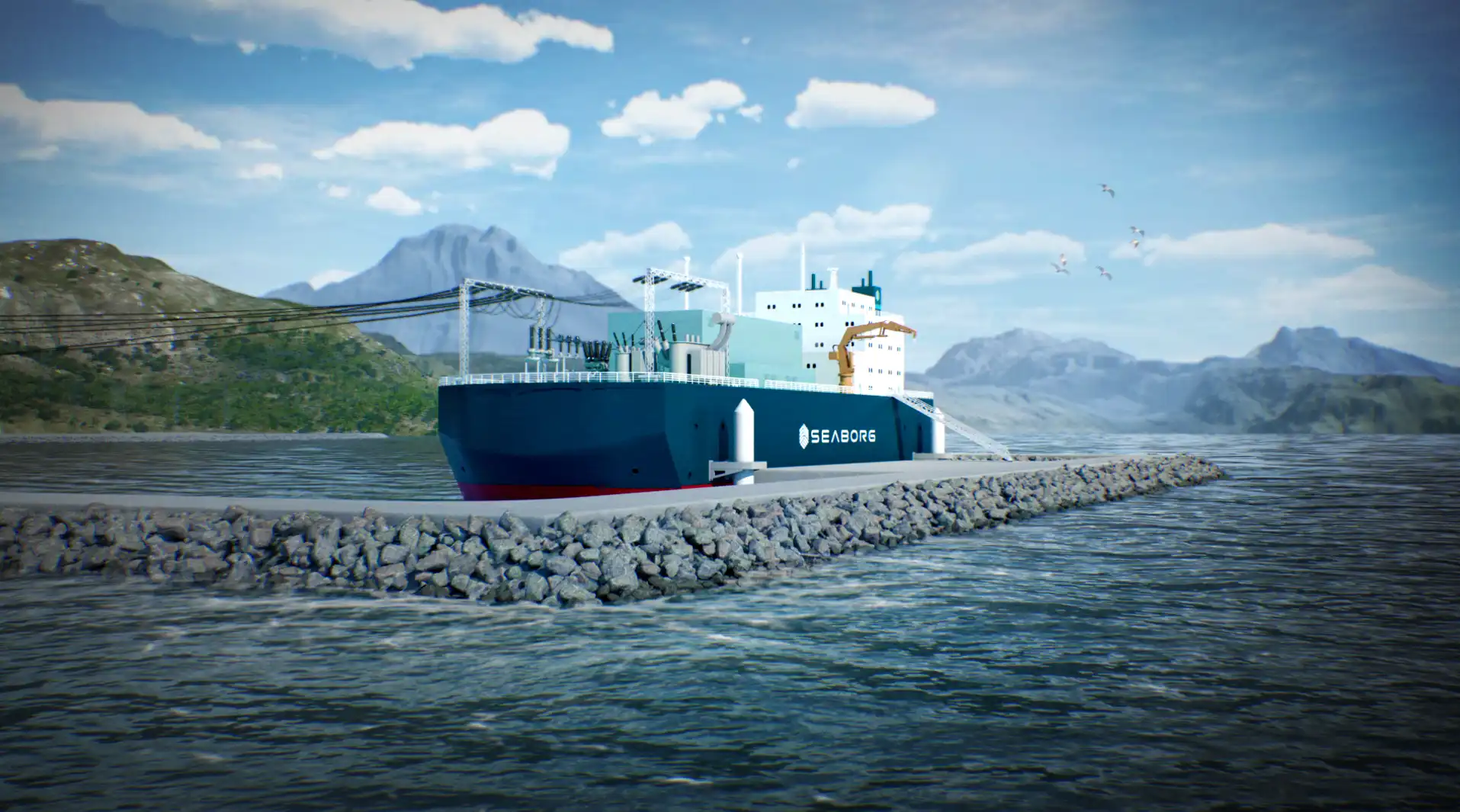Reactor Institute calculates fuel properties for floating nuclear power plants
TU Delft experts investigate a mixture of fluorides for a compact nuclear reactor with the Danish start-up Seaborg Technologies. Their Power Barge can hold up to eight such reactors and provide up to 800 megawatts of electricity.

© Stephan Timmers
Text Jos Wassink
The Power Barge is an original idea for CO2-free power generation in the near future. Almost a decade ago, a bunch of physicists in Copenhagen put their heads together to come up with a solution to rising CO2 emissions and energy poverty. Their choice fell on nuclear power with a molten salt reactor, in part because of its compact construction and inherent safety (more on this later). The compact molten salt reactor is small enough to fit in a ship’s hold. The idea for the Power Barge was born: a ship with two to eight compact nuclear reactors on board that, moored in an industrial port, silently delivers between 200 and 800 megawatts of electricity to the grid. The fuel has to be replaced every 12 years and the reactor every 24 years. Incidentally, the ship can also contribute to a heat grid, industrial heat and/or seawater desalination, reports Seaborg Technologies – now a start-up employing more than 100 people. Their goal is to deliver the first energy ship in 2028.
Delfts research
For the composition and properties of the molten salt that comprise the core of the reactor, Seaborg turned to Dr Anna Smith of the Reactor Institute Delft (Radiation Science & Technology department, Faculty of Applied Sciences). Trained as a chemist and materials scientist, Smith completed her PhD at the University of Cambridge, in close collaboration with the European Commission Joint Research Centre (JRC) in Karlsruhe (Germany). There she experimented with uranium, neptunium and plutonium. At TU Delft, Smith set up her own line of research into the materials chemistry of molten salts (fluorides and chlorides) for nuclear applications. In late 2022, Seaborg and TU Delft signed a one-year contract for a postdoc position for Dr Lukasz Ruszczynski. He would conduct research on the chemistry of molten salt as a fuel under the supervision of Smith as part of an innovative design for a Compact Molten Salt Reactor (CMSR).

The simulation shows that uranium (blue) and fluoride (green) tend to stick together more than sodium (orange) and potassium (pink) do.
© Lukasz Ruszczynski
Calculating salts
Look, says Lukasz Ruszczynski as he flips open his laptop to show how the properties of the molten salts are calculated. He starts a Molecular Dynamics simulation programme that calculates properties such as heat capacity, viscosity, thermal conductivity and density of molten salts. He loads 800 ions into the simulation – a mixture of positive ions of potassium, sodium, uranium and negatively charged fluorine ions. The programme then calculates how the ions behave under the influence of electrostatic attraction and repulsion, polarisation and dispersion forces. A million steps later, a kind of average picture has emerged showing that uranium fluoride salt, unlike pure potassium and sodium fluorides, tends to form a network structure of elongated chains. The addition of uranium fluoride makes a mixture of potassium and sodium fluoride more viscous. “These are important outcomes for the engineers designing the reactor,” says Ruszczynski. “They need to know such things when sizing the pipes and the capacity of the pumps.”
Molten salt reactor
The process is inherently safe because if the molten salt gets too hot, should the nuclear reaction go too fast for example, a plug melts and all the fuel runs to the dump tanks where nuclear fission stops. So meltdown, the nightmare of conventional nuclear power plants, cannot happen here. Also, the reactor cannot explode because the nuclear fission process takes place at atmospheric pressure. High pressure only occurs in the steam generator. Another important advantage is that its liquid nature means that the fuel can be re-processed quite easily, for instance to remove undesirable fission products and recover the valuable fissile material. Seaborg Technologies’ goal is to close the fuel cycle and thus not produce any (long-lived) radioactive waste.
The molten salt reactor is one of six reactor types included in the fourth generation of nuclear reactors. Generation IV reactors are designed for safety and durability. Balancing all these advantages is the technological challenge of dealing with molten salt at more than 600 degrees – a substance that, besides being radioactive and red-hot, is also extremely corrosive. American researchers showed that it could already be done back in the 1960s. The Molten Salt Reactor Experiment (MSRE) took place at Oak Ridge National Laboratory between 1964 and 1969. Initially, thorium fluoride and later uranium fluoride circulated in the core. Afterwards, the conclusion was that a molten salt reactor was a feasible concept and that the experiment had provided useful information. Coincidence or not: the director of the US Energy Commission at the time was Nobel laureate G.T. Seaborg, a tireless advocate for the peaceful use of nuclear energy.
So what makes a molten salt reactor attractive?
The nuclear fuel, which in Seaborg’s case is low-enriched uranium, is dissolved in a fluoride salt UF4 that circulates through the reactor tubes along with sodium and potassium fluoride (NaF and KF). The tubes are surrounded by graphite which acts as a moderator and slows down the neutrons released during nuclear fission so they can split other uranium nuclei more efficiently. Control rods at the top of the reactor vessel absorb neutrons to keep the nuclear chain reaction to the desired critical level. As it passes through the reactor, the temperature of the molten salt mixture (NaF-KF-UF4) rises from 600 to 700 degrees Celsius. Heat exchangers subsequently cool down the salt mixture to 600 degrees and use the released heat to generate steam that drives an electricity generator.
‘Climate promises create an urgent need for nuclear power’
Climate targets
Climate goals brought renewed interest in the compact molten salt reactor half a century later. In the latest version of the Dashboard report, the Nuclear Energy Agency (NEA) mapped more than 20 start-ups worldwide working on some form of molten salt reactor. Seaborg is one of them. According to NEA analysis in the report, about 10% of electricity worldwide currently comes from nuclear power plants. To stay within the maximum warming limit of 1.5 degrees, that needs to be three times more by 2050. This will require keeping existing nuclear plants running longer and building new ones. But the real hope is for small molten salt reactors that can cut CO2 emissions locally and reduce energy dependence, the NEA said.
After a year of research at TU Delft, Ruszczynski has now returned to Copenhagen to work on the development of the molten salt reactor as a computational chemist. Seaborg aims to develop the CMSR as a flexible and CO2-free power source, particularly in East and Southeast Asia. “There are already contacts with South Korea, Vietnam and Indonesia,” he says. “Cities there are densely populated and are now mainly powered by coal-fired plants. There is insufficient renewable energy available and so climate promises create an urgent need for nuclear power.” Seaborg has signed contracts with Samsung in South Korea for the construction of barges to house the reactors. From 2030, a key benchmark date in climate policy, Seaborg Technologies expects to mass produce and operate the power boats.

Illustration of the Powerbarge. From 2030, Seaborg Technologies expects to mass produce the power boats.
© Seaborg Technologies
